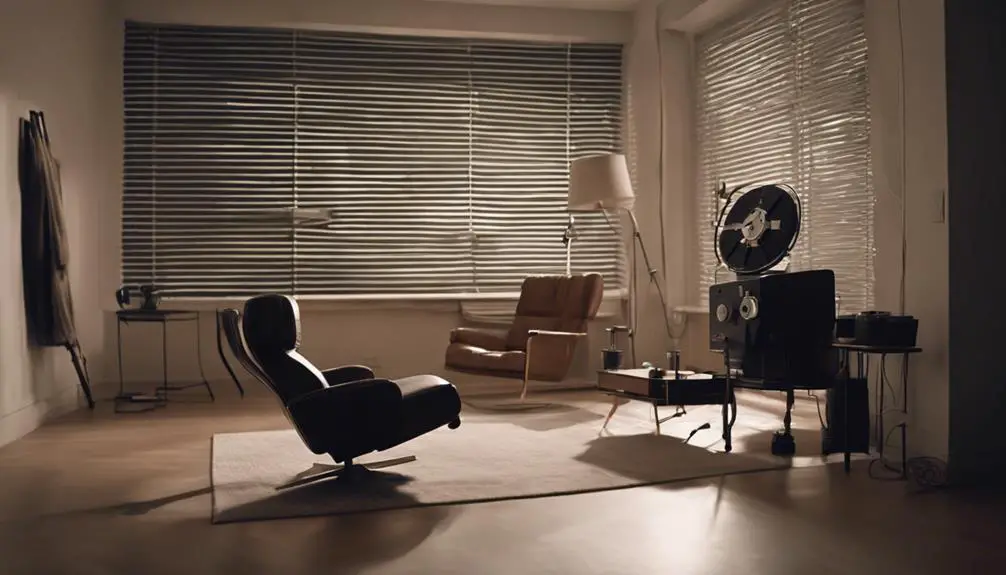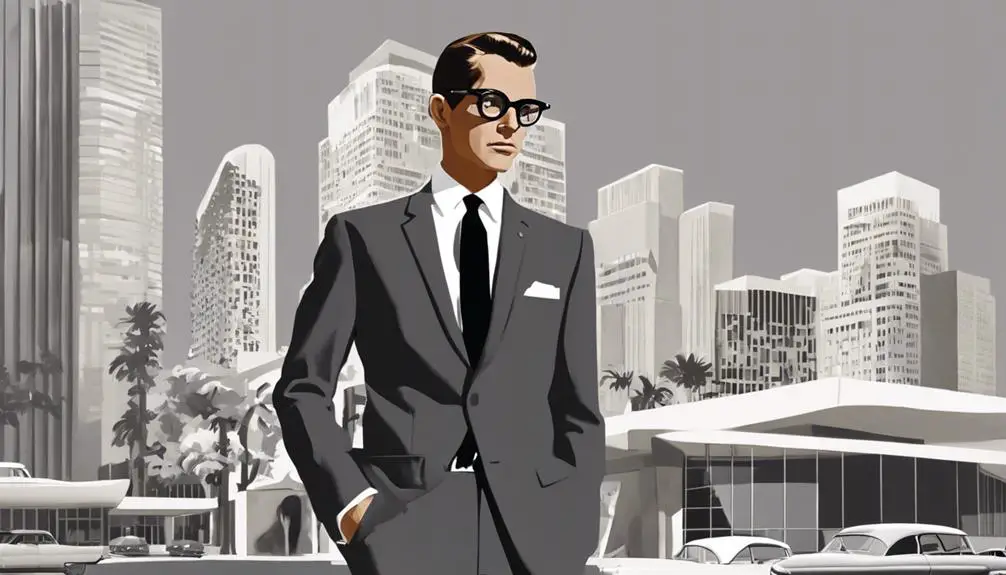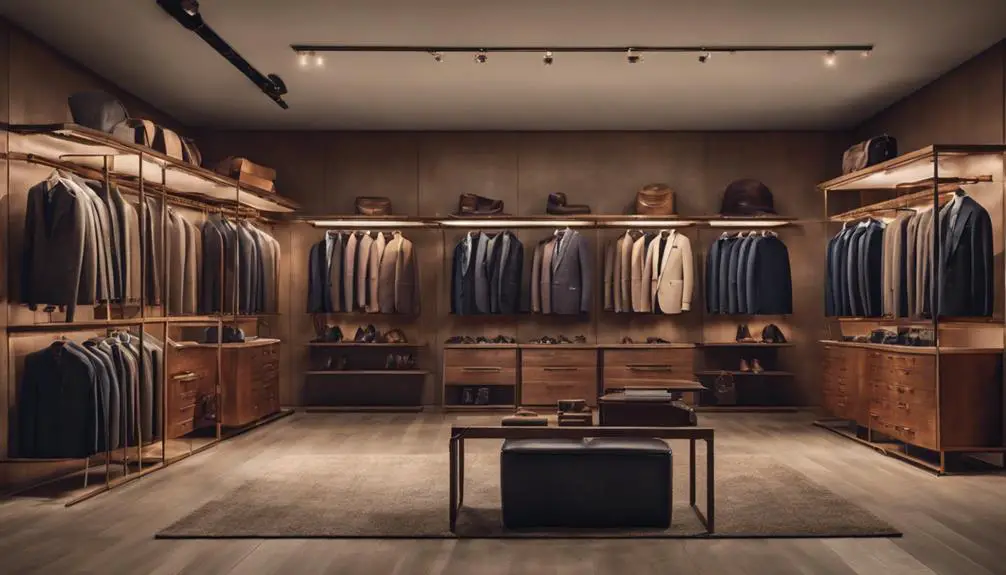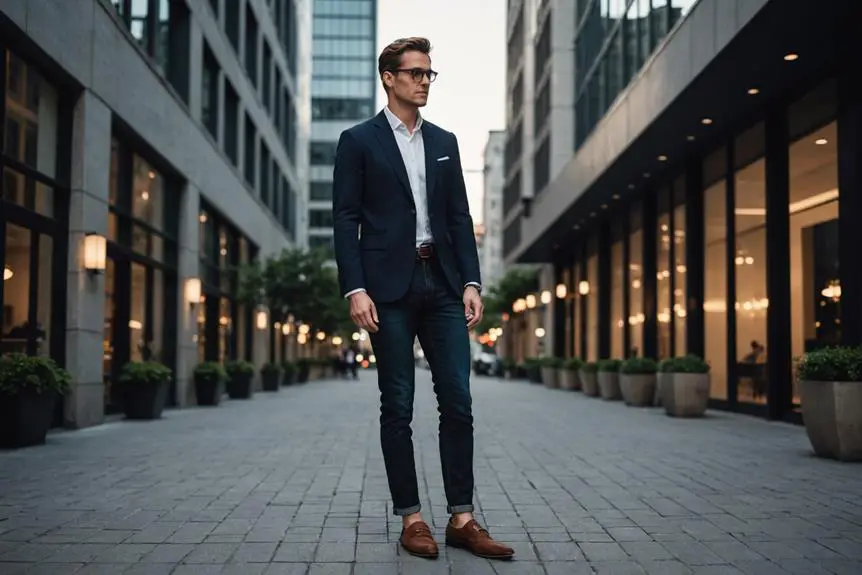When you consider the outfits in "A Single Man," it's clear that every piece of clothing serves a purpose beyond mere aesthetics. George Falconer's wardrobe, meticulously crafted by Arianne Phillips, reflects his internal struggle and quest for meaning in a chaotic world. Each item, from his crisp white shirt to his polished shoes, tells a story about masculinity and elegance in the 1960s. But what does this reveal about the character's emotional state, and how does it resonate with modern audiences? Exploring these nuances can uncover deeper layers of the film's narrative.
Film Aesthetics and Direction

In "A Single Man," directed by Tom Ford, every frame is a demonstration of meticulous craftsmanship. You're immediately captivated by the film's stunning aesthetics, which blend fashion and visual storytelling seamlessly. The costume designer plays a pivotal role in shaping the narrative, using the 1960s classic menswear to reflect the protagonist George's sophisticated yet troubled character. Each outfit isn't just clothing; it's an extension of George's emotional state, accentuating his journey through grief and longing.
Tom Ford's direction elevates the film's visual storytelling, with every shot carefully composed to enhance the mood. You'll notice how the color palette shifts, mirroring George's psychological landscape; warmer tones during moments of connection contrast sharply with cooler hues during his isolation. This deliberate use of light and color doesn't just look beautiful—it serves a purpose, deepening your understanding of George's internal struggles.
The film's stylish presentation draws parallels between fashion and storytelling, emphasizing how thoughtful costume choices reveal deeper character insights. As you watch, it becomes clear that each outfit tells a story of its own, making you more engaged in George's experience. Ford's meticulous attention to detail in both wardrobe and cinematography creates a visually striking narrative that resonates emotionally, proving that film aesthetics can be as powerful as the story itself. In "A Single Man," the visuals aren't just there for flair; they are integral to understanding the profound themes woven throughout the film.
Protagonist's Character and Style
Sophistication defines George's character in "A Single Man," as portrayed by Colin Firth. His meticulously curated wardrobe reflects the elegance of the 1960s, showcasing tailored suits that exude class and polished shoes that speak to his attention to detail. This attention to detail can be likened to the tag identification process used in vintage fashion, where every element contributes to the overall aesthetic. You'll notice how George's daily routines mirror his obsessive tendencies, particularly in his immaculate appearance. This meticulousness isn't just about looking good; it's a reflection of his inner turmoil and quest for order amidst chaos.
The white shirt is central to George's wardrobe, symbolizing his struggle for control and personal expression in the face of profound grief. You can see how it serves as the foundation of his minimalist yet polished aesthetic. Paired with dark trousers, a slim black satin tie, and classic Oxford shoes, this ensemble creates a striking visual that encapsulates his character's complexity.
Colin Firth as George uses fashion not merely as a tool for self-presentation, but as a means to cope with loss. Each outfit you see in the film tells a story, underscoring his emotional struggles while also highlighting his sophistication. The visual impact of his style is both enchanting and deeply moving, inviting you to appreciate how fashion can serve as a powerful form of expression. In "A Single Man," George's character isn't just defined by what he wears; it's how he wears it, revealing layers of his personality and experiences with every well-chosen piece.
Signature Outfits of George Falconer

Throughout "A Single Man," George Falconer's signature outfits reveal much about his character and emotional landscape. Portrayed by Colin Firth, George embodies the sophistication of 1960s fashion through his immaculate and polished wardrobe. His signature look typically includes a crisp white shirt paired with dark trousers, complemented by a slim black satin tie and polished Oxford shoes. This timeless ensemble not only highlights his attention to detail but also mirrors his quest for order in the midst of emotional chaos. The careful selection of fabrics and tailored fits in his clothing echoes the history and evolution of fashion, emphasizing the significance of style in defining personal identity.
The white shirt stands out as a central piece in George's wardrobe, symbolizing his obsessive tendencies while also serving as a canvas for personal expression. Each meticulously chosen outfit reflects his longing for connection and stability, providing insight into his grieving heart. The film's costume designer, Arianne Phillips, emphasizes minimalism and elegance, ensuring that every element of George's attire enhances the narrative of his experience.
As you watch, you'll notice how George's signature outfits become a visual representation of his internal struggles. The combination of tailored suits and period-appropriate accessories not only showcases his sophisticated style, but it also invites you to empathize with his emotional turmoil. The black and white elements of his wardrobe echo the stark contrasts in his life, accentuating both his polished exterior and the grief that lies beneath. Ultimately, George Falconer's signature outfits serve as a powerful storytelling device, inviting you to explore deeper into his poignant journey.
Symbolism in Wardrobe Choices
Amid the meticulously crafted wardrobe choices in "A Single Man," each piece serves as a reflection of the characters' inner lives. George Falconer's wardrobe, particularly his iconic white shirt, symbolizes his obsessive quest for control and order amid the chaos of grief following his partner's death. You can see how the polished shoes and slim ties he wears reveal his desire to maintain a facade of sophistication and normalcy, even when his emotions are anything but stable. This contrast between his immaculate appearance and his internal emotional turmoil deepens the film's exploration of identity and loss.
On the other hand, Julianne Moore's character embodies faded elegance through her wardrobe choices, which signify the passage of time and the lingering impact of past relationships. Her outfits, while stylish, reflect a subtle nostalgia that adds layers to her character, making you ponder the emotional weight she carries.
Moreover, the use of period-correct design elements reinforces the film's 1960s setting, lending authenticity to the narrative while enhancing the emotional resonance of the characters' experiences. Each wardrobe choice not only supports the story but also weaves a rich tapestry of symbolism that invites you to dive deeper into the characters' psyches. As you analyze these visual cues, you'll appreciate how effectively the film uses wardrobe to express complex emotions and themes, making every outfit a crucial piece of storytelling.
Influence of 1960s Fashion

The influence of 1960s fashion in "A Single Man" is evident not just in George Falconer's wardrobe but also in how it shapes the film's overall aesthetic. You can see this through George's sophisticated outfits, which prominently feature tailored suits that perfectly embody the era's elegance. Arianne Phillips, the film's costume designer, meticulously crafts each look to reflect the clean lines and refined aesthetics that defined the decade. Key pieces like the iconic white shirt paired with a slim black satin tie serve as staples, showcasing the simplicity and sophistication of 1960s fashion. The meticulous tailoring of these suits mirrors the craftsmanship seen in vintage varsity jackets, where attention to fit and detail is essential for an impeccable look ensure alterations do not compromise jacket integrity.
The muted color palette and classic silhouettes present in the film highlight a shift from the flamboyant styles of previous decades to a more understated elegance. This attention to detail not only captures the sartorial trends of the time but also immerses you in an atmosphere of subtle sophistication. The high-quality fabrics and precise tailoring elevate George's wardrobe, making every outfit a reflection of the craftsmanship of the era.
Moreover, the film's portrayal of 1960s menswear resonates with contemporary fashion, inspiring modern interpretations that prioritize sophistication and elegance. You might find yourself drawn to the timeless appeal of tailored suits and minimalist accessories, realizing just how influential this period continues to be. By weaving these elements into the narrative, "A Single Man" not only celebrates the past but also encourages you to embrace the elegance of 1960s fashion in your own wardrobe.
Impact of Costume Design
In "A Single Man," costume design serves as a vital storytelling tool that intricately weaves together the emotional landscape of the characters. Arianne Phillips, the talented costume designer, meticulously crafted George's wardrobe to reflect his emotional struggles. His tailored suits and signature white shirt symbolize his quest for order amidst the chaos of grief. You'll notice how George's polished Oxford shoes and slim black satin tie enhance the film's 1960s setting, grounding him firmly in his time while revealing layers of his character.
George's immaculate appearance acts as emotional armor, concealing his inner turmoil and showcasing his psychological states. When you see him dressed so sharply, it's easy to overlook the sadness lurking underneath. In contrast, Julianne Moore's character, Charley, is adorned in vintage pieces that evoke a sense of faded elegance, emphasizing her connection to George and the passage of time. Her outfits reflect not just her identity but also the emotional weight she carries.
The film's costumes do more than just establish characters; they visually narrate the story. George's clean and sophisticated attire starkly contrasts with his underlying sadness and longing, drawing you into his world. Each outfit you see is a carefully chosen piece in the puzzle of his life, illustrating how costume design impacts not just the aesthetic but also the emotional depth of the narrative. This thoughtful approach to costume design elevates the film, making it a poignant exploration of love and loss.
Lasting Legacy of A Single Man

Costume design in "A Single Man" not only enhances the narrative but also leaves a lasting mark on the world of fashion. When you think of timeless menswear, it's hard not to recall George Falconer's impeccably tailored wardrobe, which has become an iconic reference point for sophistication. The film, directed by Tom Ford, showcases the best-dressed man of the 1960s, demonstrating how a well-considered outfit can convey deep emotional layers and character development. The evolution of fashion in film parallels the shifts seen in brands like Abercrombie & Fitch, which have adapted their style and branding over the decades to resonate with changing consumer preferences and cultural movements, reflecting the importance of logo changes in identifying vintage pieces.
Arianne Phillips, the film's award-winning costume designer, crafted looks that resonate with contemporary audiences, influencing modern style trends. Her meticulous attention to detail not only set a benchmark for costume design but also inspired a generation of designers to prioritize visual storytelling through clothing. The classic silhouettes, rich fabrics, and striking color palettes showcase how menswear can embody masculinity while still being elegant and refined.
The lasting legacy of "A Single Man" extends beyond the screen; it has impacted how men approach fashion today. The blend of art and style within the film emphasizes the powerful intersection between cinema and fashion, making it a touchstone for anyone interested in expressing their identity through clothing. As you explore your own style, remember that the essence of George Falconer's wardrobe continues to inspire those who dare to embrace sophistication, ensuring that the influence of A Single Man endures in the fashion world for years to come.
Frequently Asked Questions
What Is a Single Man Movie About?
Imagine a world painted in muted colors, where you witness George's character development through emotional themes of grief and longing. The fashion significance accentuates his internal struggles, revealing a poignant journey toward connection amidst despair.
What Is the Movie About a Woman Who Dresses Like a Man?
You're exploring a film about a woman challenging societal norms through her fashion choices. Her androgynous style reflects her gender identity journey, showcasing how clothing can empower and symbolize rebellion against traditional expectations.




